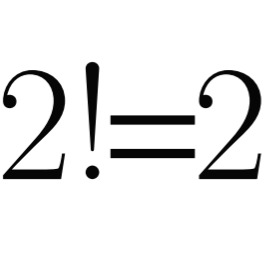In this post, we will learn about the group action. In mathematics, a group action on a set is a group homomorphism of a given group into the group of permutations of the set. Let's look at the definition below.
이번 글에서는 group action에 대해 알아볼 것이다. 집합 위의 group action은 주어진 군에서 위의 순열의 군으로 가는 homomorphism을 말한다. 아래의 정의를 보자.
Definition 1.
|
Let be a group and let be a set. An action of on is a homomorphism of into the group of permutations of . We then call a -set. We denote the permutation associated with an element by and thus the homomorphism is denoted by . We often abbreviate the notation and write simply instead of .
군 와 집합 가 주어졌다고 하자. 위의 의 작용 ( Action )은 에서 의 순열의 군 로 가는 homomorphism 이다. 이러한 action이 주어진 경우, 를 -Set이라고 부르며, 가 대응되는 순열을 와 같이 나타내며, 따라서 앞서 언급한 homomorphism은 로 나타낸다. 일반적으로, group action의 경우, 대신에 와 같이 나타낸다.
|
With the simpoler notation above, we have the two familiar properties. Look at the theorem below:
위의 표기 중 더 간단한 표기를 사용한다면, 두 가지 익숙한 성질을 얻을 수 있다. 아래의 정리를 보자.
Theorem 1.
|
The following statements are satisfied:
(a) For all and , we have .
(b) If is the identity element of , then for all .
아래의 명제들이 성립한다.
(a) 임의의 와 에 대하여 가 성립한다.
(b) 만약 가 의 항등원이라면, 임의의 에 대하여 가 성립한다.
|
Proof.
Part (a)
Since is a group-homomorphism, .
가 group-homomorphism이므로 가 성립한다.
Part (b)
Since is a group-homomorphism, must be an identity element of the group . Thus, is the identity map on .
가 group-homomorphism이므로 는 군 의 항등원이어야 한다. 따라서 는 위의 항등함수이다.
Conversely, if we are given a mapping , denoted by , satisfying these two properties, then for each the map is a permuation of , which we then denote by . Then is a homomorphism of into . So an action of on could also be defined as a mapping satisfying the above two properties. The most important examples of representations of as a group of permutations are the following.
역으로, 만약 Theorem 1의 두 명제 (a), (b)를 만족하는 사상 가 주어진다면, 각 에 대하여 사상 는 위의 순열임을 알 수 있으며, 이 사상을 로 나타내게 되면, 는 에서 로 가는 group-homomorphism이 됨을 알 수 있다. 따라서 위의 의 action은 위의 두 성질을 만족하는 사상 로 정의할 수도 있다. 아래는 이러한 의 action의 몇 가지 예시이다.
Example 1. Conjugation
For each , let be the map such that . Then it is immediately verified that the association is a homomorphism , and so this map gives an action of on itself, called conjugation. The kernel of the homomorphism is a normal subgroup of , which consists of all such that for all , i.e., all which commute with every element of . This kernel is called the center of . automorphisms of of the form are called inner.
To avoid confusion about the action on the left, we don't write for . Sometimes, one writes , i.e., one uses exponential notation, so that we have the rules and for all . Similarly, and .
We note that also acts by conjugation on the set of subsets of . Indeed, let be the set of subsets of , and let be a subset of . Then is also a subset of which may be denoted by , and one verifies trivially that the map of is an action of on . We note in addition that if is a subgroup of then is also a subgroup, so that acts on the set of subgroups by conjugation.
각 에 대하여 를 과 같이 정의되는 함수라고 하자. 그러면 가 에서 로 가는 group-homomorphism이 됨은 자명하며, 이 사상이 켤레라고 불리는, 위의 의 action을 정의함을 알 수 있다. 이때, 의 kernel은 의 정규부분군이 되며, 이를 의 Center라고 한다. 또한, 의 Automorphism 중 꼴의 함수들을 Inner라고 한다.
왼쪽에서 작용하는 것과 혼동하지 않게 하기 위해 는 로 나타내지 않는다. 대신 일부 저자들은 와 같이 나타내기도 하며, 비슷하게 는 와 같이 나타낸다. 당연하지만, 임의의 에 대하여 와 가 성립한다.
는 위로 작용할 뿐 아니라 의 멱집합 위로도 작용한다. 를 의 모든 부분집합의 집합이라 하고 를 생각하자. 그러면 역시 의 부분집합이 되며, 이를 와 같이 나타낼 수 있다. 그러면 자명하게도 이 위의 의 action이 되며, 만약 가 의 부분군이라면, 역시 의 부분군이 되므로 는 그의 부분군의 집합 위로 켤레로서 작용함을 알 수 있다.
Example 2. Translation
For each we define the translation by . Then the map defines an action of on itself.
Similarly, acts by translation on the set of subsets, for if is a subset of , then is also subset of . If is a subgroup of , then is in general not a subgroup but a coset of , and hence we see that acts by translation on the set of cosets of . We denote the set of left cosets of by . Thus even though need not be normal, is a -set. It has become customary to denote the set of right cosets by .
각 에 대하여 를 와 같이 정의되는 함수라고 하자. 그러면 는 위의 의 action을 정의한다. 이를 Translation이라고 한다.
비슷하게, 는 의 멱집합 위로 translation으로서 작용한다. 만약 가 의 부분집합이라면, 역시 의 부분집합이다. 또한, 만약 가 의 부분군이라면, 는 의 부분군이 아닐 수는 있지만, 의 coset이 되며, 따라서 는 의 coset의 집합 위로 translation으로서 작용함을 알 수 있다. 따라서 가 의 정규부분군이 아니라 하더라도 가 -set임을 알 수 있다.








